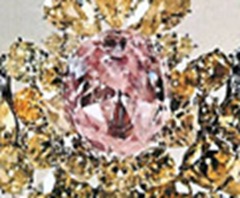Introduction
Noor-ol-Ain is the second largest historic oval pink diamond that dates back to the Mughal dynasty. It is the sister stone of Darya-ye-noor diamond.

History of the stone & Meaning of the stone’s name
Noor-ol-Ain is a persian word meanings the light of the eye. It is one of the largest pink diamonds in the world and is believed to have once formed part of an even larger gem. The Noor-ol-ain Diamond is believed to be a portion of the fabled Great Table Diamond. The fabled great Table Diamond had also been described in the journal of the French jeweller Jean-Baptiste Tavernier in 1642, who called it the "Diamanta Grande Table".The fabled great Table Diamond was cut to form Darya-ye-noor Diamond and a smaller part called Noor-ol-ain Diamond. It was in possession of the Mughal emperors. In 1739, Nader Shah of Persia invaded Northern India, and as payment for returning the crown of India to the Mughal emperor, Muhammad, he took possession of the entire fabled treasury of the Mughals, including the Darya-ye-noor, Noor-ol-ain, the Koh-i-noor and the Peacock throne. All of these treasures were carried to Iran by Nader Shah and both of these pieces, Darya-ye-noor, Noor-ol-ain, are currently part of the Iranian Crown Jewels.
Characteristics of Diamond
Noor-ol-Ain diamond is a pale pink second largest diamond weighing around 60 carats (12 g), oval in shape.
Noor-ol-ain Diamond is Type IIa diamonds. These diamonds are almost or entirely devoid of impurities, and consequently are usually colorless, have the highest thermal conductivity as well as are very transparent in ultraviolet. Usually Type IIa diamonds have imperfections that impart yellow, brown, orange, pink, red, or purple color to the gem.